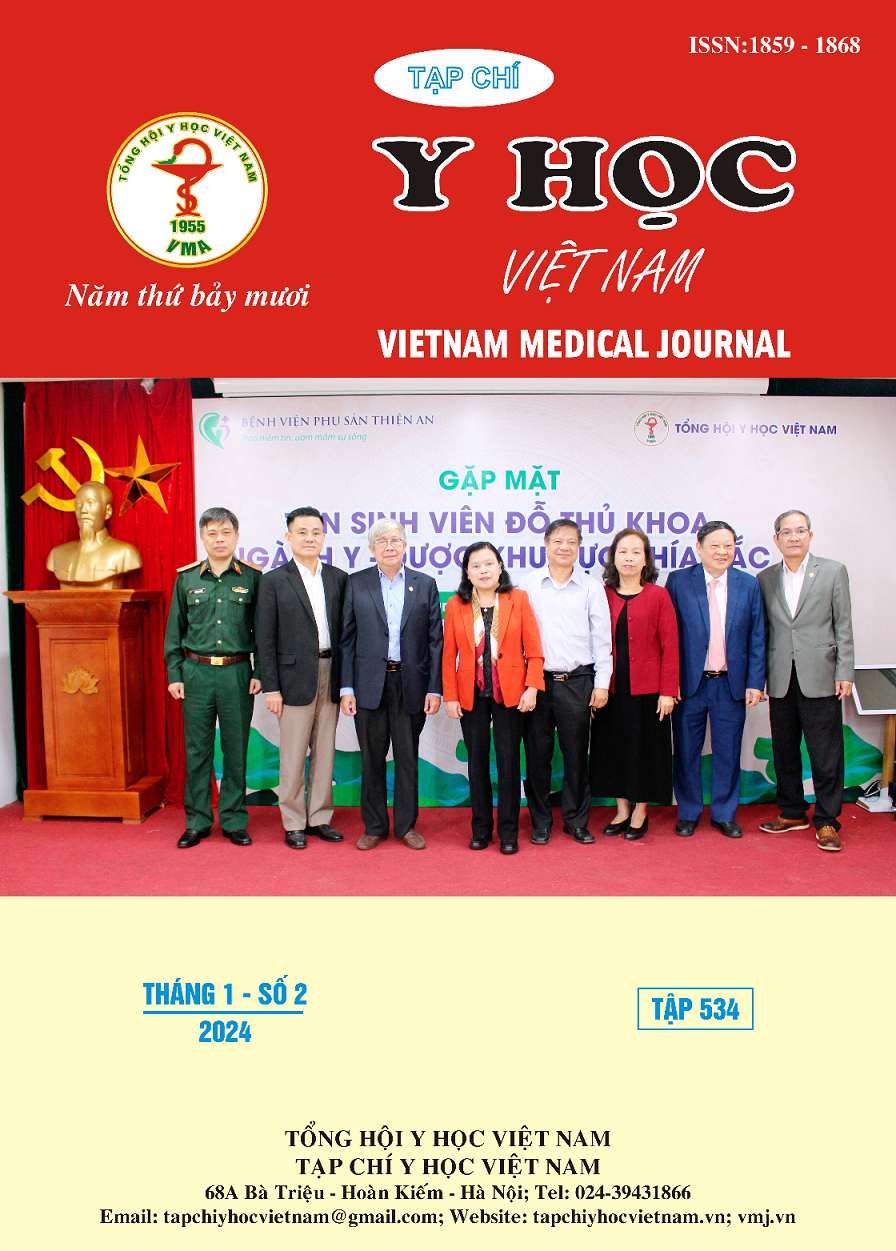VENTILATION-RELATED PNEUMONIA AT BACH MAI HOSPITAL POISON CENTER IN 2022 - 2023
Main Article Content
Abstract
Objective: to describe the clinical features, laboratory characteristics and risk factors for ventilator associated pneumonia (VAP) at the Poison Control Center of Bach Mai Hospital. Subjects and methods: descriptive study was conducted on 364 mechanically ventilated patients including 107 patients with VAP from January 2021 to July 2023. Results: The average age of the study patients was 52.4±17.5 years old. The incidence of VAP was 29.4% with a frequency of 38.1/1000 days of mechanical ventilation. The average onset time of VAP was 7.0 ± 4.0 days, late-onset VAP accounted for 72.9%. Common clinical symptoms when developed VAP were fever (87,9%), rales (100%), and tachypnea (94.4%). Average CPIS score was 9.1±1.6. Laboratory abnormalities were increased white blood cells (above 12 G/L) (60.7%), increased Pro-calcitonin above 0.5 ng/mL (77.6%), diffuse pulmonary infiltrates in chest X ray (60.7%) and lung consolidation (39.3%). Conclusion: The study revealed the incidence, main clinical, laboratory characteristics and risk factors for ventilator associated pneumonia at the Poison Control Center in 2022 - 2023.
Article Details
References
2. Papazian L, Klompas M, Luyt CE. Ventilator-associated pneumonia in adults: a narrative review. Intensive Care Med. 2020;46(5):888-906. doi:10.1007/s00134-020-05980-0
3. Hoàng Khánh Linh. Nghiên Cứu Đặc Điểm Viêm Phổi Liên Quan Thở Máy Tại Khoa Hồi Sức Tích Cực Bệnh Viện Bạch Mai Giai Đoạn 2017 - 2018. Luận văn bác sỹ chuyên khoa cấp II. Đại học Y Hà Nội; 2018.
4. Bùi THG, Nguyễn ĐQ. Đặc điểm kháng kháng sinh và các yếu tố nguy cơ tử vong của nhiễm khuẩn bệnh viện tại khoa hồi sức tích cực bệnh viện bạch mai. VMJ. 2022;515(1). doi:10.51298/ vmj.v515i1.2666
5. Kollef MH, Chastre J, Fagon JY, et al. Global prospective epidemiologic and surveillance study of ventilator-associated pneumonia due to Pseudomonas aeruginosa. Crit Care Med. 2014;42(10): 2178-2187. doi:10.1097/ CCM. 0000000000000510
6. Hoàng Anh TT. Đánh giá vi khuẩn và tình trạng kháng kháng sinh của các loại vi khuẩn gây viêm phổi liên quan đến thở máy tại đơn vị Hồi sức ngoại bệnh viện Bạch Mai năm 2020. Luận văn thạc sĩ y học Trường Đại học Y Hà Nội.
7. But A, Yetkin MA, Kanyilmaz D, et al. Analysis of epidemiology and risk factors for mortality in ventilator-associated pneumonia attacks in intensive care unit patients. Turk J Med Sci. 2017;47(3):812-816. doi:10.3906/sag-1601-38
8. Chang L, Dong Y, Zhou P. Investigation on Risk Factors of Ventilator-Associated Pneumonia in Acute Cerebral Hemorrhage Patients in Intensive Care Unit. Can Respir J. 2017;2017:7272080. doi:10.1155/2017/7272080
9. Liu Y, Di Y, Fu S. Risk factors for ventilator-associated pneumonia among patients undergoing major oncological surgery for head and neck cancer. Front Med. 2017;11(2):239-246. doi:10. 1007/s11684-017-0509-8
10. Thư NK, Đức ND. Căn nguyên vi khuẩn gây viêm phổi liên quan thở máy trên bệnh nhân điều trị tại bệnh viện đại học y hà nội. VMJ. 2023; 525(1B). doi:10.51298/vmj.v525i1B.5127


